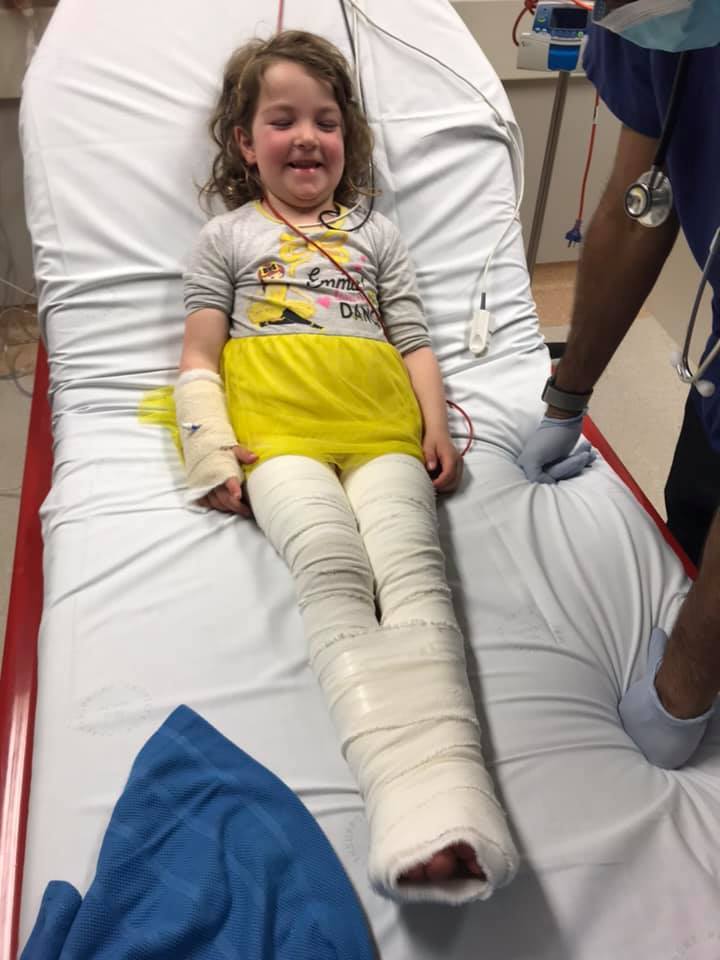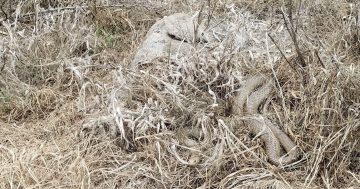
Gabby had a close encounter with a brown snake during the October long weekend. Photo: Supplied.
Four-year-old Gabby McDonald was walking with her mother, Lana, and sister, Josie, on their farm in Laggan, 45 minutes northwest of Goulburn, on Friday, 2 October, when she stepped on a brown snake.
“Gabby was about two metres in front of me and I noticed a tail wiggling by her feet,” recalls Lana.
“I called out to warn her so she stepped off the snake, but as she was looking at it the snake raised its head and went to attack her.
“Gabby ran to me and the snake slid off. I checked she was OK and that she didn’t have any bite marks on her. I had Josie, my youngest, with me as well so I quickly grabbed both of them and carried them 200 metres back to the house.”
The snake struck Gabby’s gumboot with its mouth closed, which is a warning sign according to Raymond McGibbon, a snake catcher in the Illawarra, Southern Highlands and surrounding regions.
He says snakes will nose-butt or dummy strike a person or predator as a warning before biting.
Lana is a qualified nurse and while she was confident the snake hadn’t bitten Gabby, she took her daughter to the nearest hospital in Crookwell to be sure.
“I thought I would rather be safe than sorry,” says Lana. “What if there was a tiny scratch and some venom had gone in, and I missed it and something happened overnight?”
The snake was light brown in colour and about 50cm to one metre in length, she says.
Lana and her husband, Caspar, are used to seeing brown and copperhead snakes on their rural property, but not this close.
“Lately, there have been four or five dead snakes on the road from here to town so I knew they were around,” she says.
Raymond says Gabby’s gumboots would have protected her from a brown snake bite because they have small fangs. However, a red-bellied black snake – which has the longest fangs of all Australian snakes – could have pierced the boots.
“I recommend people wear covered shoes and loose clothing when they’re outside,” he says. “If you’re wearing loose fitting pants, the snake will bite the material and not your leg.”
At the hospital, doctors and nurses wrapped Gabby’s legs in bandages to immobilise her in case she was bitten, and then observed her overnight.
“The staff decided to take the precautionary steps to be safe and they did an amazing job,” says Lana. “Gabby thought she was a mermaid when they put the bandages on her!”
The staff at Goulburn Base Hospital – where Gabby was transported to by an ambulance later in the day – took blood from her 12 hours after the potential bite.
“A snakebite can take up to 12 hours to show up,” explains Lana.
In 10 years of nursing at Crookwell District Hospital, Lana has never treated a snakebite.
“They are quite rare,” she says.
However, Raymond explains that he has received more than 50 phone calls from people wanting snakes removed from their properties since mid-August.
He says the snake season started when the temperature began to rise, and that recent rain has prompted more of the slithery creatures to come out of their winter hiding.
“The rain has drawn out a lot more food sources, such as mice, rats and rabbits, which snakes eat,” says Raymond. “In your area, you’ll find brown, red-bellied black, copperhead and tiger snakes, which eat frogs and fish, and there are a lot of those around at the moment.”
First aid for a snakebite:
- Get the person away from the snake.
- Ensure they rest, and help them to stay calm.
- Call triple zero (000) and ask for an ambulance.
- Apply constant, firm pressure to the bite area and keep the person still. If you can, put a pressure bandage over the bite itself and then use a heavy crepe or elasticised roller bandage to immobilise the whole arm or leg. Start just above the fingers or toes of the bitten limb and move upwards on the limb as far as the body. Splint the limb, including joints on either side of the bite.
- Don’t wash the bite area — venom left on the skin can help identify the snake.
- Do not apply a tourniquet, cut the wound or attempt to suck the venom (poison) out.
(Source: Health Direct)









